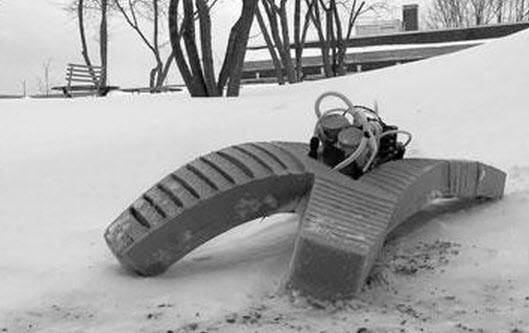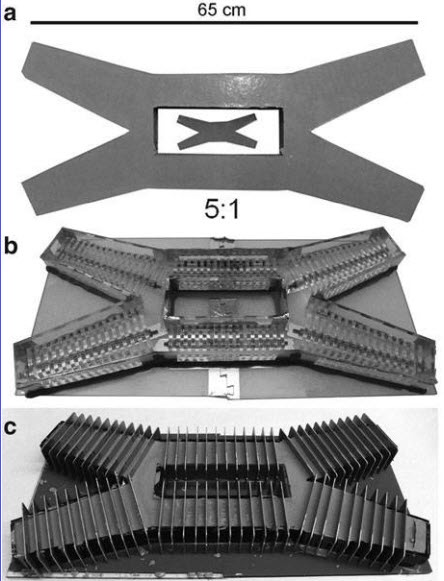These bots were made for walkin’
September 8, 2014

Walk this way: a soft robot successfully executed its walking gait outside during a snowstorm (Winter Storm Nemo) with an average temperature of – 9C(15F), and average wind speed of 40 km/h (25 mph) (credit: Michael T. Tolley et al./Soft Robotics)
An autonomous shape-changing soft robot that walks on its own four “legs” has been developed by advanced materials chemist George Whitesides, PhD and colleagues and is featured (open access) in the current issue of Soft Robotics, a peer-reviewed journal from Mary Ann Liebert, Inc., publishers.

First three steps in fabricating soft untethered robot (credit: Michael T. Tolley et al./Soft Robotics)

The June 2014 issue of Soft Robotics (credit: Mary Ann Liebert, Inc., publishers)
Imagine a 0.65-meter-long (2 feet), non-rigid, shape-changing, four-legged robot walking at 18 meters (59 feet) per hour that can operate without the constraints of a tether and perform demanding tasks in challenging environments — such as search-and-rescue in unstable rubble and flames, snowstorm, and puddles of water — and work for several hours using a battery pack (or longer, with a lightweight electrical tether) while carrying payloads of up to 8 kilograms (17 pounds).
Michael Tolley, PhD and a multidisciplinary team of coauthors from the School of Engineering and Applied Sciences, Wyss Institute for Biologically Inspired Engineering, and Department of Chemistry and Chemical Biology at Harvard University and the School of Mechanical and Aerospace Engineering at Cornell University detail in the article the innovative composite materials, design features, and fabrication methods they used.
To keep down the weight, they used silicone embedded with hollow glass spheres, polyaramid fabric, and two mini air compressors (MACs) as diaphragm pumps, driven by electrical motors.
“This paper marks the emergence of soft robot technology from the research lab into the real world,” says Editor-in-Chief Barry A. Trimmer, PhD, who directs the Neuromechanics and Biomimetic Devices Laboratory at Tufts University.
Abstract of Soft Robotics paper
A pneumatically powered, fully untethered mobile soft robot is described. Composites consisting of silicone elastomer, polyaramid fabric, and hollow glass microspheres were used to fabricate a sufficiently large soft robot to carry the miniature air compressors, battery, valves, and controller needed for autonomous operation. Fabrication techniques were developed to mold a 0.65-meter-long soft body with modified Pneu-Net actuators capable of operating at the elevated pressures (up to 138 kPa) required to actuate the legs of the robot and hold payloads of up to 8 kg. The soft robot is safe to interact with during operation, and its silicone body is innately resilient to a variety of adverse environmental conditions including snow, puddles of water, direct (albeit limited) exposure to flames, and the crushing force of being run over by an automobile.